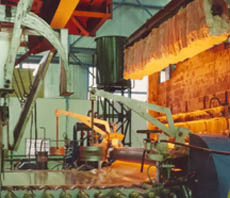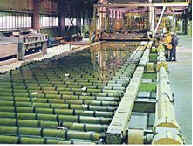
History of Glass
 Natural glass has existed for millions of years as a result of high temperature and naturally occurring events such as volcanic eruptions, lightning strikes and the impact of meteorites. Stone Age man used a type of this natural glass known as obsidian to make weapons and tools.
Natural glass has existed for millions of years as a result of high temperature and naturally occurring events such as volcanic eruptions, lightning strikes and the impact of meteorites. Stone Age man used a type of this natural glass known as obsidian to make weapons and tools.
The earliest man made glass objects were non-transparent glass beads believed to have originated in Egypt around 2500 B.C. Later, the Egyptians began developing glass pots by dipping a core mold of compacted sand into molten glass and then turning the mold so that the molten glass would adhere to it. While still soft, the glass-covered mold would be rolled on a slab of stone in order to smooth it.
A significant breakthrough in glass making occurred with the inception of glass blowing in Syria around the first century B.C. A long thin metal tube was inserted into molten glass and removed. Then craftsmen would blow into the tube giving a hollow shape to the glass. Sometime thereafter, the ancient Romans began blowing glass inside of molds greatly increasing the variety of shapes for hollow glass items. About the same time, the Romans started to utilize glass for architectural purposes, although the windows were thick cast blocks and weren’t very clear. As the Roman Empire expanded, so too did their skill of glass making.
 |
|
Bubbled glass
|
In the middle ages the Italian city of Venice became the leader in glass production. The Venetians were experimenting with different raw materials, like crystal, in an attempt to create a clearer type of glass. The Italians did not want their craftsmen or technology to be duplicated so they forced the glassmakers to work and reside on the island of Murano, enabling the Venetians to ensure that no trade secrets were exported.
In 1674 an Englishman named George Ravenscroft developed lead crystal. He had been tasked to find an alternative to the highly prized Venetian crystal, which was comprised of pure quartz sand and potash. By using greater proportions of lead oxide instead of potash, he succeeded in producing a sparkling glass with a high reflective index. This glass was well suited for deep cutting and engraving because it was softer and contained a higher lead count.
In the late 1600’s, the French developed a new process for the production of plate glass. The molten glass was poured onto a special table and rolled out flat. After cooling, the plate glass was ground on large round tables by means of rotating cast iron discs. Fine abrasive sands were used to grind surface imperfections from the plate surface. Subsequently, the plates were polished using felt discs. The result was flat glass with superior optical qualities, which became an industry standard at the time. Known globally as French panes—this term is still used in the industry today to describe multiple small windows in a single frame. In addition to being suitable architectural glass, these plates were also coated on one side with a reflective low melting point metal to create high quality mirrors.
 |
|
Making glass
|
It wasn’t until the latter stages of the industrial revolution that mechanical technology led to
the mass production of glass. Glass blowing machines, automated rollers and tank furnaces all saw their debut during this period. At the same time, scientific research was being conducted in order to figure out the relationship between the composition
of glass and its inherent physical properties.
The glass manufacturers were funding this research in a quest to improve and diversify their product offerings. In France, Edward Benedictus started strengthening glass by means of lamination, which was basically a celluloid material layer sandwiched between two sheets of glass. He patented this process in 1910 under the name “Triplex”.
The last significant advancement in the mass production of flat glass was the float process developed after the second world war by Britain’s Pilkington Brothers Ltd. Introduced in 1959, it enabled manufacturers to combine the brilliant finish of sheet glass with the optical properties of plate glass. Molten glass is poured across a bath of molten tin. There it’s spread and flattened before being drawn into an annealing lehr where it is cooled at varying rates. By varying the cooling temperatures, manufacturers can alter the strength of the glass. This is the primary method of glass production in use today.
Glass Manufacturing
Modern glass manufacturing techniques have evolved through centuries of glass making, but for the last several decades the Float Process method has dominated the industry. Ninety-five percent of the world's glass is produced by this practice. Each manufacturer’s float “line” is different, and production varies depending on facility and product capacity.
The basic manufacturing process involves five steps:
 |
|
Ingredients for glass
|
Step 1 – The first step is called batch mixing where the right ingredients are chosen. The most commonly used ingredients are silica (usually in the form of sand), soda ash, limestone, dolomite, felspar, sodium sulphate, coal dust and cullet (broken glass). These ingredients can be used in varying amounts in order to influence the finished product.
Step 2 – The second step involves melting the ingredients
at the hot end of a lehr (the machinery which produces glass) inside a furnace heated to about 2800 degrees Fahrenheit.
This turns the ingredients into a pliable molten gel.
Step 3 – The third step is simply allowing the resulting furnace “gel” to be added to a bath of molten tin, which is heated to around 1900 degrees F. Because the density of tin is far greater than molten glass, the glass actually “floats” on the top of the tin. The glass spreads out in the tin bath and is allowed enough time for irregularities to flow out so it becomes flat and parallel. Because the surface of molten tin is exceptionally flat, the glass also becomes flat. The ribbon of glass is then cooled down while still advancing across the molten tin. When the glass surface is hard enough to avoid impressions by the roller, it’s removed from the bath. The speed at which the glass moves through the bath influences its dimensional characteristics. Slow moving glass causes a greater thickness to the finished product while faster speeds will result in a thinner glass.
Step 4 – The fourth step is called the annealing process in which the glass is carried over a long conveyor system to the annealing lehr and cooled off by air jets of decreasing temperature. When the glass first enters the annealing lehr, the temperature is approximately 1100 degrees F. At the end of the process, the glass will have cooled to around 400 degrees F. By altering the curing procedure, manufacturers can create a different hardness to the glass. The glass is then washed and prepped for the final glass production step.
 |
|
Glass cutting
|
The key benefit to the float process is that it allows glass production to take place on a very large scale. The results are an excellent finished product that can be manipulated
at all stages of production process in order to create a wide array of glass products.